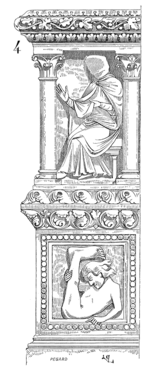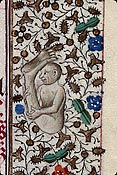
Monopod (creature)
Encyclopedia

Greek language
Greek is an independent branch of the Indo-European family of languages. Native to the southern Balkans, it has the longest documented history of any Indo-European language, spanning 34 centuries of written records. Its writing system has been the Greek alphabet for the majority of its history;...
, monocoli from μονοκωλοι - 'one legged' in Greek.
Origin
According to Carl A.P. Ruck, the Monopods's cited existence in India refers to the VedicRigvedic deities
There are 1028 hymns in the Rigveda, most of them dedicated to specific deities.Indra, a heroic god, slayer of Vrtra and destroyer of the Vala, liberator of the cows and the rivers; Agni the sacrificial fire and messenger of the gods; and Soma the ritual drink dedicated to Indra are the most...
Aja Ekapad ("Not-born Single-foot"), an epithet for Soma
Soma
Soma , or Haoma , from Proto-Indo-Iranian *sauma-, was a ritual drink of importance among the early Indo-Iranians, and the subsequent Vedic and greater Persian cultures. It is frequently mentioned in the Rigveda, whose Soma Mandala contains 114 hymns, many praising its energizing qualities...
. Since Soma is a botanical deity the single foot would represent the stem of an entheogen
Entheogen
An entheogen , in the strict sense, is a psychoactive substance used in a religious, shamanic, or spiritual context. Historically, entheogens were mostly derived from plant sources and have been used in a variety of traditional religious contexts...
ic plant or fungus. http://www.sciencedirect.com/science?_ob=ArticleURL&_udi=B6T8D-475B966-1W&_user=10&_coverDate=09%2F30%2F1981&_rdoc=1&_fmt=high&_orig=search&_sort=d&_docanchor=&view=c&_searchStrId=1214011531&_rerunOrigin=google&_acct=C000050221&_version=1&_urlVersion=0&_userid=10&md5=7ca093a479a58c3700d8c10a5725b173
It is possible that the myth derived from a misinterpretation of the practice of Indian yogis (sadhu
Sadhu
In Hinduism, sādhu denotes an ascetic, wandering monk. Although the vast majority of sādhus are yogīs, not all yogīs are sādhus. The sādhu is solely dedicated to achieving mokṣa , the fourth and final aśrama , through meditation and contemplation of brahman...
) who sometimes meditate on one foot.
Chronicles of Narnia
C.S. Lewis introduces monopods in the book The Voyage of the Dawn TreaderThe Voyage of the Dawn Treader
The Voyage of the Dawn Treader is a fantasy novel for children by C. S. Lewis. Written in 1950, it was published in 1952 as the third book of The Chronicles of Narnia...
, a part of his children's fiction/fantasy series The Chronicles of Narnia
The Chronicles of Narnia
The Chronicles of Narnia is a series of seven fantasy novels for children by C. S. Lewis. It is considered a classic of children's literature and is the author's best-known work, having sold over 100 million copies in 47 languages...
.


Coriakin
Coriakin is a fictional character in C. S. Lewis's Chronicles of Narnia. He appears in The Voyage of the Dawn Treader.-Biographical summary:...
, who was charged with their care. They were originally regular dwarves, with two legs, but were transformed into monopods by Coriakin, as a punishment. The Duffers were so unhappy with their appearance (they said that they had been "uglified") that they made themselves invisible. Lucy Pevensie later made them visible again. They were (re)discovered by explorers from the Narnian ship, the Dawn Treader
Dawn Treader
The Dawn Treader was a Narnian ship in the fictional world of The Chronicles of Narnia. It was built by King Caspian X and is featured primarily in the book The Voyage of the Dawn Treader...
, which had landed on the island to rest and resupply. The ship was on an expedition to the furthest east; both a voyage of discovery, and a search for a previous Narnian vessel that had been sent on a similar expedition years earlier.
After sorting out certain misunderstandings about Coriakin's role on the island, the visiting Narnians (and three British children from mid-twentieth century Earth: siblings Edmund and Lucy Pevensie and their cousin Eustace Scrubb) taught the Duffers how to navigate on water. By using small oars and jumping on the water lightly, foot-first, the monopodal dwarves were able to row themselves about, each floating on their single, large shoe. Before leaving, the travelers renamed the Duffers "Monopods"; however, the Duffers soon mixed up the name, saying " 'Moneypuds, Pomonods, Poddymons.' " Eventually, they settled on the name "Dufflepuds".
The Dufflepuds looked liked other Narnian dwarves, aside from their monopodality. Their one leg was usually about three feet long, and ended in a large foot, clad in a boat-shaped shoe. When they slept, each dwarf lay on their back with their foot in the air, acting as a kind of umbrella
Umbrella
An umbrella or parasol is a canopy designed to protect against rain or sunlight. The term parasol usually refers to an item designed to protect from the sun; umbrella refers to a device more suited to protect from rain...
over them; creating a mushroom-like appearance, when viewed from a distance. According to Brian Sibley
Brian Sibley
Brian Sibley is an English writer. He is author of over 100 hours of radio drama and has written and presented hundreds of radio documentaries, features and weekly programmes.- Early life :...
's book The Land of Narnia, Lewis may have based their appearance on drawings from the Hereford Mappa Mundi
Hereford Mappa Mundi
The Hereford Mappa Mundi is a mappa mundi, of a form deriving from the T and O pattern, dating to ca. 1300. It is currently on display in Hereford Cathedral in Hereford, England...
.
Skiapods in Baudolino
Umberto EcoUmberto Eco
Umberto Eco Knight Grand Cross is an Italian semiotician, essayist, philosopher, literary critic, and novelist, best known for his novel The Name of the Rose , an intellectual mystery combining semiotics in fiction, biblical analysis, medieval studies and literary theory...
in his novel Baudolino
Baudolino
Baudolino is a 2000 novel by Umberto Eco about the adventures of a young man named Baudolino in the known and mythical Christian world of the 12th century.Baudolino was translated into English in 2001 by William Weaver...
describes a sciapod named Gavagai. The name of the creature "Gavagai" is a reference to Quine'
Willard Van Orman Quine
Willard Van Orman Quine was an American philosopher and logician in the analytic tradition...
s example of indeterminacy of translation
Indeterminacy of translation
The indeterminacy of translation is a thesis propounded by 20th century analytic philosopher W. V. Quine. The classic statement of this thesis can be found in his 1960 book Word and Object, which gathered together and refined much of Quine's previous work on subjects other than formal logic and set...
.
Other
Sciapod is also part of the Monster in My PocketMonster in My Pocket
Monster in my Pocket is a media franchise developed by Morrison Entertainment Group, headed by Joe Morrison and John Weems ....
series.
There is a South American legend of a monopod woman named 'Patasola
Patasola
The Patasola or "one foot" is one of many myths in South American folklore about female monsters from the jungle, appearing to male hunters or loggers in the middle of the wilderness when they think about women...
'.
Sukiya Podes (a Japanization then re-romanization of Skiapodes) is a character in the Puyo Puyo
Puyo Puyo
is the inaugural game in the Puyo Puyo series originally released in 1991 by Compile for the MSX2. Since its creation, it uses characters from . It was created by Masamitsu "Moo" Niitani, the founder of Compile, who was inspired by certain elements from the Tetris and Dr...
series.
In the Legend Owain, or the Lady of the Fountain, a massive sciapod is mentioned to have control over the animals and to have outstanding physical strength.
Talk Radio personality Hugh Hewitt
Hugh Hewitt
Hugh Hewitt is an American radio talk show host with the Salem Radio Network, lawyer, academic, and author. An outspoken Republican, evangelical Christian, he comments on society, politics, and media bias in the United States. Hewitt is also a law professor at Chapman University School of Law.-...
refers to his listeners that follow on Twitter
Twitter
Twitter is an online social networking and microblogging service that enables its users to send and read text-based posts of up to 140 characters, informally known as "tweets".Twitter was created in March 2006 by Jack Dorsey and launched that July...
as Dufflepuds http://hughhewitt.townhall.com/talkradio/transcripts/Transcript.aspx?ContentGuid=69197bda-5d82-40ac-837e-b5668a4c228e or Tribbles, especially when employing use of the hashtag "#hhrs" in Tweets.
Brazilian modernist Tarsila do Amaral's painting "Abaporu" is said to be a representation of a sciapod.
Tim MacIntosh-Smith briefly refers to edible monopod poets in the preface to 'Yemen - Travels in Dictionary Land'
See also
- Kasa-obakeKasa-obake, or Karakasa Obake or Karakasa Kozo, are a type of Tsukumogami, a folk legend about a form of Japanese spirit that originate from objects reaching their 100th year of existence, thus becoming animate. Karakasa in particular are Spirits of Parasols that reach the century milestone...
- Kui (Chinese mythology)Kui (Chinese mythology)Kui is a polysemous figure in ancient Chinese mythology. Classic texts use this name for the legendary musician Kui who invented music and dancing; for the one-legged mountain demon or rain-god Kui variously said to resemble a Chinese dragon, a drum, or a monkey with a human face; and for the...
- Saci (Brazilian folklore)Saci (Brazilian folklore)The Saci is considered the most popular character in Brazilian folklore. He is a one-legged black or mulatto youngster with holes in the palms of his hands, who smokes a pipe and wears a magical red cap that enables him to disappear and reappear wherever he wishes...
- InvuncheInvuncheIn the Chilote folklore and Chilote mythology of the Chiloé Island in southern Chile, the imbunche or invunche is a legendary monster that protects the entrance to a warlock's cave.-Legend:...

